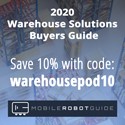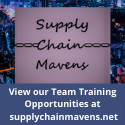575: Fulfillment Operations Excellence at Scale with Dr. Squatch
In this episode of The New Warehouse Podcast, host Kevin speaks with Andrew Sutton, Senior Director of Fulfillment Operations at Dr. Squatch, the popular men’s personal care brand. Known for its witty marketing and commitment to natural ingredients, Dr. Squatch has exploded in popularity across direct-to-consumer (D2C) and retail channels.
Andrew shares how his career evolved from a seasonal customer service rep to leading fulfillment strategy at one of the fastest-growing brands in the men’s care space. Dr. Squatch’s bold marketing approach—featuring memorable campaigns with Mike Tyson and Sydney Sweeney—has helped fuel its rapid rise and strong brand recognition. This conversation dives into the decisions behind outsourcing fulfillment, navigating rapid growth, and why Dr. Squatch has built an internal fulfillment team despite not operating its own warehouses.
Building a Fulfillment Operations Team Without a Warehouse
Andrew is clear-eyed about the stakes of fulfillment operations, stating, “Poor fulfillment is one of the quickest ways to lose a customer.” As unconventional as it sounds, Andrew leads a 10-person internal fulfillment operations team at Dr. Squatch, even though the company outsources its logistics.
They now work with seven 3PLs across 12 global locations, dividing operations by channel: D2C, marketplaces, and retail. This channel-specific strategy ensures that each fulfillment operations partner is “best in class” for the job. “We made the intentional decision on our end to take on that complexity…to ultimately support better customer experience, drive up that demand, lifetime value (LTV).”
He sees his team’s role as invisible yet essential: if they’re doing their job right, customers never even think about fulfillment—their products simply arrive, on time and as expected.
From Shark Tank to Strategic Scaling
Before Dr. Squatch, Andrew was on the frontlines of explosive growth at Tipsy Elves—a holiday apparel company that gained national attention after appearing on Shark Tank. Their segment aired during peak season just a few weeks before Christmas, creating a massive and immediate spike in demand.
“It was just incremental volume on top of what had already been our busiest weeks of the year,” Andrew recalls. The company struggled with forecasting and technical capacity, including website crashes, but its 3PL partners managed the surge thanks to preemptive planning and strong relationships.
This experience shaped Andrew’s view of fulfillment as a key driver of operational success and brand value. “If you can’t perform against that [subscription order], that’s tough,” he says, underscoring how delivery delays can instantly erode customer trust.
Partnering for the Long Haul: Lessons from the 3PL Frontlines
Despite being fully outsourced, Dr. Squatch treats its 3PLs like an extension of the team. That mindset shows up in everything from data sharing to pizza parties. “We want them to be invested in a mutual win-win opportunity on both sides through all the levels,” Andrew explains.
One of the most powerful lessons? Visit the 3PL sites and build authentic relationships. “They only hear from brands when they’re upset. We occasionally buy our 3PL teams just pizza parties…so they know that we appreciate them.”
Forecasting is another area of focus. “You can’t just throw them a forecast that says ‘up 5% from last year’… they want to perform well, but you have to support them with the right info.” This high level of engagement has allowed Dr. Squatch to reduce costs while improving on-time delivery and customer satisfaction. “Every way we’ve invested in fulfillment has returned net positive,” Andrew confirms, making the case for hands-on, proactive management even in an outsourced model.
Key Fulfillment Operations Takeaways from Dr. Squatch
- Dr. Squatch operates with seven 3PLs across 12 global locations to support its complex, multichannel fulfillment strategy.
- Poor fulfillment is one of the quickest ways to lose a customer.
- Partnering closely with 3PLs—through site visits, accurate forecasting, and relationship-building—has helped reduce costs and boost customer satisfaction.
Listen to the episode and leave your thoughts in the comments.
Guest Information
Website: Dr. Squatch
LinkedIn: Andrew Sutton
Email: andrew@drsquatch.com
For more information about fulfillment operations, check out the podcasts below.
560: Fulfillment Trends in 2025 with DCL Logistics
553: Scaling Fulfillment Strategies for Modern Health Brands




